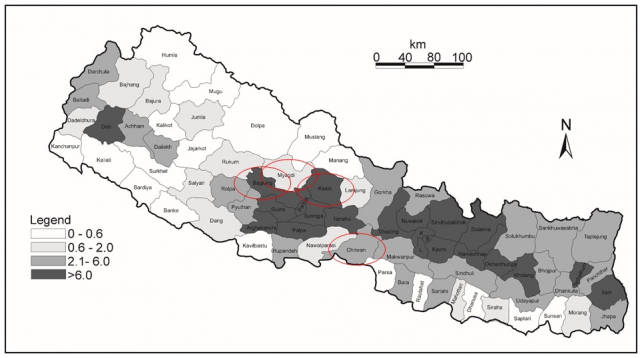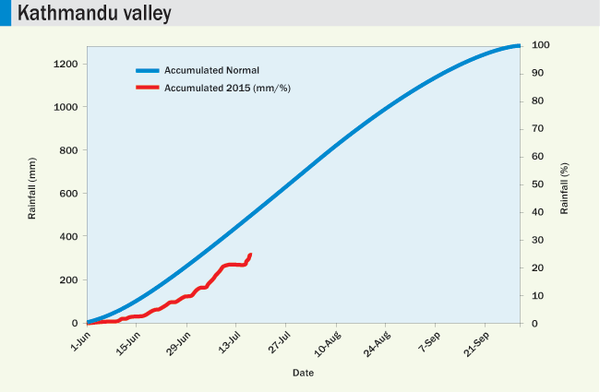31 July 2015
Nepal landslides: over 30 killed yesterday in Kaski and Myagdi
Posted by Dave Petley
Kaski and Myagdi landslides
Heavy monsoon rainfall yesterday triggered landslides in Nepal, most notably in Kaski and Myagdi districts, killing over 30 people. Landslides also occurred in Baglung and Chitwan. The map below is from Petley et al. (2007), which looked at monsoon landslides across Nepal. The dark colours indicate those areas most affected by landslides. I have highlighted in red the four districts hit by landslides yesterday:
.
Worst affected was Kaski District, which is very landslide-prone. The landslides that caused loss of life include:
Kaski District:
- 19 fatalities in a landslide at Majhgaun in Lumle
- Five fatalities in a landslide at Bhadure Tamagi
- Two fatalities in a landslide at Dhikurpokhar
Myagdi District:
- Seven fatalities in a landslide at Mudi and Muna Villages
Baglung Distruct
- One fatality in a landslide at Rayadanda
Chitwan District
- One fatality in a landslide at Siddhi
Meanwhile the road between Pokhara and Baglung was also blocked by landslides.
The landslide at Lumle is particularly interesting. Ekantipur describes it as follows:
“Our correspondent in Kaski said 23 people, including seven of a family, died while six others went missing at Majhgaun in Lumle-6. The casualty was high as a water tank with the capacity of 20,000 litres was swept just above the settlement. Ten houses were buried. Local people and security personnel rescued three people immediately after the disaster.”
Note that different reports suggest different numbers of fatalities. Hopefully this will become clearer in the days ahead. Whilst it is tempting to link this to the earthquake, this is looks like just a normal monsoon rainfall event, the sort that happens every year. So far we are not seeing anomalously high levels of landslides, primarily because the monsoon is very weak. This graph shows rainfall through the first half of the month in Kathmandu versus the average (from My Republica):
.
On average July is the month with the heaviest rainfall in Nepal, but there is so much inter-annual variation that it should not be assumed that we are out of the woods as yet.
Meanwhile, the USGS has produced an excellent report on the earthquake induced landslides in Nepal. This is an invaluable resource.
Reference
Petley, D.N., Hearn, G.J., Hart, A., Rosser, N.J., Dunning, S.A., Oven, K., and Mitchell, W.A. 2007. Trends in landslide occurrence in Nepal. Natural Hazards 43:23–44.




 Dave Petley is the Vice-Chancellor of the University of Hull in the United Kingdom. His blog provides commentary and analysis of landslide events occurring worldwide, including the landslides themselves, latest research, and conferences and meetings.
Dave Petley is the Vice-Chancellor of the University of Hull in the United Kingdom. His blog provides commentary and analysis of landslide events occurring worldwide, including the landslides themselves, latest research, and conferences and meetings.